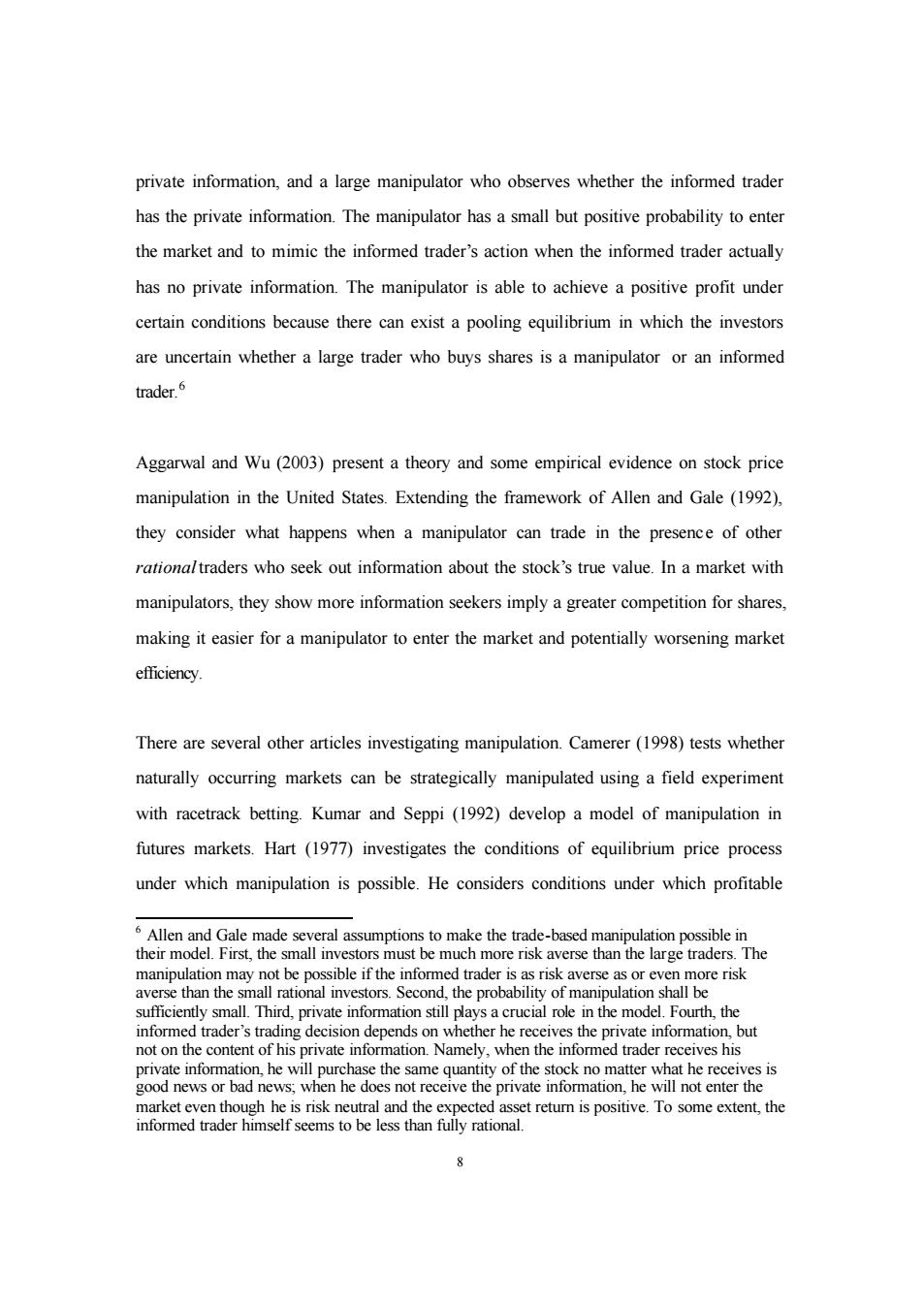正在加载图片...

private information,and a large manipulator who observes whether the informed trader has the private information.The manipulator has a small but positive probability to enter the market and to mimic the informed trader's action when the informed trader actually has no private information.The manipulator is able to achieve a positive profit under certain conditions because there can exist a pooling equilibrium in which the investors are uncertain whether a large trader who buys shares is a manipulator or an informed trader.6 Aggarwal and Wu (2003)present a theory and some empirical evidence on stock price manipulation in the United States.Extending the framework of Allen and Gale (1992), they consider what happens when a manipulator can trade in the presence of other rationaltraders who seek out information about the stock's true value.In a market with manipulators,they show more information seekers imply a greater competition for shares, making it easier for a manipulator to enter the market and potentially worsening market efficiency. There are several other articles investigating manipulation.Camerer (1998)tests whether naturally occurring markets can be strategically manipulated using a field experiment with racetrack betting.Kumar and Seppi (1992)develop a model of manipulation in futures markets.Hart (1977)investigates the conditions of equilibrium price process under which manipulation is possible.He considers conditions under which profitable 6 Allen and Gale made several assumptions to make the trade-based manipulation possible in their model.First,the small investors must be much more risk averse than the large traders.The manipulation may not be possible if the informed trader is as risk averse as or even more risk averse than the small rational investors.Second,the probability of manipulation shall be sufficiently small.Third,private information still plays a crucial role in the model.Fourth,the informed trader's trading decision depends on whether he receives the private information,but not on the content of his private information.Namely,when the informed trader receives his private information,he will purchase the same quantity of the stock no matter what he receives is good news or bad news;when he does not receive the private information,he will not enter the market even though he is risk neutral and the expected asset return is positive.To some extent,the informed trader himself seems to be less than fully rational. 88 private information, and a large manipulator who observes whether the informed trader has the private information. The manipulator has a small but positive probability to enter the market and to mimic the informed trader’s action when the informed trader actually has no private information. The manipulator is able to achieve a positive profit under certain conditions because there can exist a pooling equilibrium in which the investors are uncertain whether a large trader who buys shares is a manipulator or an informed trader.6 Aggarwal and Wu (2003) present a theory and some empirical evidence on stock price manipulation in the United States. Extending the framework of Allen and Gale (1992), they consider what happens when a manipulator can trade in the presenc e of other rational traders who seek out information about the stock’s true value. In a market with manipulators, they show more information seekers imply a greater competition for shares, making it easier for a manipulator to enter the market and potentially worsening market efficiency. There are several other articles investigating manipulation. Camerer (1998) tests whether naturally occurring markets can be strategically manipulated using a field experiment with racetrack betting. Kumar and Seppi (1992) develop a model of manipulation in futures markets. Hart (1977) investigates the conditions of equilibrium price process under which manipulation is possible. He considers conditions under which profitable 6 Allen and Gale made several assumptions to make the trade-based manipulation possible in their model. First, the small investors must be much more risk averse than the large traders. The manipulation may not be possible if the informed trader is as risk averse as or even more risk averse than the small rational investors. Second, the probability of manipulation shall be sufficiently small. Third, private information still plays a crucial role in the model. Fourth, the informed trader’s trading decision depends on whether he receives the private information, but not on the content of his private information. Namely, when the informed trader receives his private information, he will purchase the same quantity of the stock no matter what he receives is good news or bad news; when he does not receive the private information, he will not enter the market even though he is risk neutral and the expected asset return is positive. To some extent, the informed trader himself seems to be less than fully rational